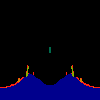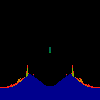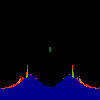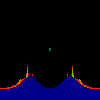















Well, the base looks pretty darn circular, right? Its not. It's ever so
slightly eccentric (nothing in life is easy). The shape is given by
the often quoted "cardiod",
z = 0.5 * exp (i*phi) - 0.25 * exp (2*i*phi),
which, in our coordinate system,
K = 0.5 * sqrt (1.25 - cos(phi)) and
theta = arctan ( (sin(phi) - 0.5*sin(phi)) / (cos(phi) - 0.5*cos(phi))).
In this coordinate system, the cardiod is very nearly a circle,
a fact that has pained me greatly.
z <-- z*z + c == (x+i*y)*(x+i*y) + Re(c) + i*Im(c) == x*x - y*y + Re(c) + i * (2*x*y + Im(c))we play with the cross term ...
z <-- z*z + c == (x+i*y)*(x+i*y) + Re(c) + i*Im(c) == x*x - y*y + Re(c) + i * (2*x*y(1.0-lambda) + Im(c))In the sequence below, we see lambda go from 0.1 to 1.0, in steps of 0.1. Click on the prictures with the big borders.














